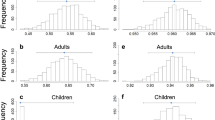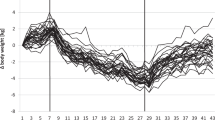Abstract
Background/Objectives:
To determine the effect of acute fluid consumption on measures of impedance and percent body fat (%BF) estimated using segmental bioelectrical impedance analysis (SBIA).
Subjects/Methods:
Seventy-six healthy, recreationally active adults (41 women; 35 men) volunteered to participate in this study (mean±s.d.; age, 21.0±1.6 years; body mass index, 25.0±3.2 kg/m2). Subjects had their body composition assessed on three separate occasions. After a baseline measurement, subjects consumed 591 ml of water (H2O), a carbohydrate/electrolyte drink (CHOE) or received nothing (CON). Subjects were reassessed 20, 40 and 60 min following (POST) the baseline measure in each fluid condition.
Results:
Twenty minutes after drinking a H2O or CHOE beverage, %BF (1.1 and 1.2%), impedance (12 and 14 Ω) and body mass increased significantly (P<0.001). During the CON trial, %BF (0.3 and 0.5%) and impedance (7 and 11 Ω) also increased significantly above baseline values at 40 and 60 min POST. However, the normal hourly variability was significantly (P<0.009) less than the observed fluid-induced %BF alterations. The greatest %BF increases were observed in the lightest subjects, who were women. Fluid type had no effect on the magnitude of change POST.
Conclusions:
Twenty minutes after drinking, %BF estimates increased approximately 1.0% due to elevations in impedance and body mass. As such, we recommend adhering to the pretest fluid restriction guideline to avoid fluid-induced alterations in SBIA body composition measures. In addition, use of a consistent testing schedule may minimize normal %BF variation over time.
This is a preview of subscription content, access via your institution
Access options
Subscribe to this journal
Receive 12 print issues and online access
$259.00 per year
only $21.58 per issue
Buy this article
- Purchase on Springer Link
- Instant access to full article PDF
Prices may be subject to local taxes which are calculated during checkout






Similar content being viewed by others
References
Andreacci JA, Dixon CB, Lagomarsine M, Ledezma C, Goss FL, Robertson RJ (2006). Effect of a maximal treadmill test on percent body fat using leg-to-leg bioelectrical impedance analysis in children. J Sports Med Phys Fitness 46, 454–457.
Bland JM, Altman DG (1986). Statistical methods for assessing agreement between two methods of clinical measurement. Lancet 1, 307–310.
Costill DL, Saltin B (1974). Factors limiting gastric emptying during rest and exercise. J Appl Physiol 37, 679–683.
Demura S, Yamaji S, Goshi F, Nagasawa Y (2002). The influence of transient change of total body water on relative body fats based on three bioelectrical impedance analyses methods. Comparison between before and after exercise with sweat loss, and after drinking. J Sports Med Phys Fitness 42, 38–44.
Deurenberg P, Weststrate JA, Paymans I, van der Kooy K (1988). Factors affecting bioelectrical impedance measurement in humans. Eur J Clin Nutr 42, 1017–1022.
Dixon CB, Lovallo SJ, Andreacci JL, Goss FL (2006). The effect of acute fluid consumption on measures of impedance and percent body fat using leg-to-leg bioelectrical impedance analysis. Eur J Clin Nutr 60, 142–146.
Elsen R, Siu ML, Pineda O, Solomons NW (1987). Sources of variability in bioelectrical impedance determinations in adults. In Ellis KJ, YasumuraS, and Morgan WD (eds). In vivo Body Composition Studies,. Institute of Physical Sciences in Medicine: London. pp 184–188.
Gomez T, Mole PA, Collins A (1993). Dilution of body fluid electrolytes affects bioelectrical impedance measurements. Sports Med Train Rehabil 4, 291–298.
Heyward VH, Wagner DR (2004). Applied Body Composition Assessment. Human Kinetics: Champaign, IL. pp 87–98.
Kushner RF, Gudivaka R, Schoeller DA (1996). Clinical characteristics influencing bioelectrical impedance analysis measurements. Am J Clin Nutr 64, 423S–427S.
Lukaski HC (2000). Assessing regional muscle mass with segmental measurements of bioelectrical impedance in obese women during weight loss. Ann NY Acad Sci 904, 154–158.
Murray R, Bartoli WP, Eddy DE, Horn MK (1997). Gastric emptying and plasma deuterium accumulation following ingestion of water and two carbohydrate-electrolyte beverages. Int J Sports Nutr 7, 144–153.
National Institutes of Health Technology Assessment Conference (NIHTAC) (1996). Bioelectrial impedance analysis in body composition measurement. Am J Clin Nutr 64, 524S–532S.
Nunez C, Gallagher D, Visser M, Pi-Sunyer FX, Wang Z, Heymsfield SB (1997). Bioimpedance analysis: evaluation of leg-to-leg system based on pressure contact foot-pad electrodes. Med Sci Sports Exerc 29, 524–531.
Oshima Y, Shiga T (2006). Within-day variability of whole-body and segmental bioelectrical impedance in a standing position. Eur J Clin Nutr 60, 938–941.
Pietrobelli A, Rubiano F, St-Onge M-P, Heymsfield SB (2004). New bioimpedance analysis system: improved phenotyping with whole-body analysis. Eur J Clin Nutr 58, 1479–1484.
Rising R, Swinburn B, Larson K, Ravussin E (1991). Body composition in Pima Indians: validation of bioelectrical resistance. Am J Clin Nutr 53, 594–598.
Roche AF, Heymsfield SB, Lohman TG (1996). Human Body Composition. Human Kinetics: Champaign, IL. pp 79–108.
Saunders MJ, Blevins JE, Broeder CE (1998). Effects of hydration changes on bioelectrical impedance in endurance trained individuals. Med Sci Sports Exerc 30, 885–892.
Shirreffs SM (2003). Markers of hydration status. Eur J Clin Nutr 57, S6–S9.
Slinde F, Bark A, Jansson J, Rossander-Hulthen L (2003). Bioelectrical impedance variation in healthy subjects during 12 h in the supine position. Clin Nutr 22, 153–157.
Acknowledgements
We would like to gratefully acknowledge all subjects for their participation in this investigation. This investigation was supported by College of Liberal Arts—Special Initiatives Award from Bloomsburg University (JLA).
Author information
Authors and Affiliations
Corresponding author
Additional information
Contributors: CBD and JLA were responsible for study design, data analysis and writing of the manuscript. EF, DR and LR were responsible for performing the experiments and data entry.
Rights and permissions
About this article
Cite this article
Dixon, C., Ramos, L., Fitzgerald, E. et al. The effect of acute fluid consumption on measures of impedance and percent body fat estimated using segmental bioelectrical impedance analysis. Eur J Clin Nutr 63, 1115–1122 (2009). https://doi.org/10.1038/ejcn.2009.42
Received:
Revised:
Accepted:
Published:
Issue Date:
DOI: https://doi.org/10.1038/ejcn.2009.42
Keywords
This article is cited by
-
The influence of coffee consumption on bioelectrical impedance parameters: a randomized, double-blind, cross-over trial
European Journal of Clinical Nutrition (2022)
-
Influence of subject presentation on interpretation of body composition change after 6 months of self-selected training and diet in athletic males
European Journal of Applied Physiology (2018)
-
The effect of a meal on measures of impedance and percent body fat estimated using contact-electrode bioelectrical impedance technology
European Journal of Clinical Nutrition (2013)



